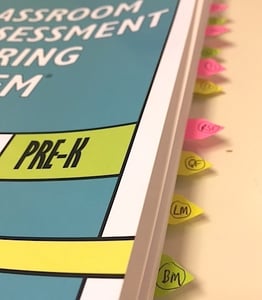
There are many ways to introduce dimensions for any CLASS tool. I have observed several trainers to see how he or she introduces the dimensions, and you know what? Although different trainers have different approaches to this, they are all effective. When I am training, I have to remember the main focus of what I am doing and that is teaching. Perfection is an illusion, but effective is attainable.
I have tried many ways of introducing the dimensions and finally found an effective way of doing it! I am confident in this approach, and my participants have enjoyed it. It is what I call, interactive lecturing.
Step 1
The first thing I do is introduce the dimension. I simply say, “Alright our next dimension is Regard for Student Perspectives. Lets all turn to page 38.” Once we have all turned there, I glance at the group and ask, “Can someone please read the definition for us out loud?” (I have learned to ask people to read out loud or else everyone will read to himself or herself). After the volunteer has read the definition, I ask the participants to highlight, circle or underline key words in the definition. This is an important piece of the training because when we begin to score and participants are stuck between a 2 or 3 or the difference between a 5 or 6, they will have to think about the dimension in a holistic manner. Highlighting key words helps participants understand each dimension.
Step 2
Next, I go indicator-by-indicator and behavior marker-by-behavior marker. The reason I am so in-depth is because I don’t want the participants feeling unprepared to conduct observations. Even though behavior markers are used as a guide and not a checklist, it’s still important for participants to know what they mean and what they look like.
As we journey through each indicator and behavior marker, I then ask, “What is our first indicator?” They reply, “Flexibility and student focus.” Sometimes I will switch it up and say that indicator first, then ask for the behavior markers. This always causes a “laugh break” because the participants think I am going to ask for the indicator, and then they reply and say the incorrect answer and we just laugh. This is a good sign, because they are recognizing the difference between indicators and behavior makers.
Step 3
Next I will say, “That’s right and our first behavior maker is shows flexibility, what might that look like?” This is the major key to making this complicated tool relatable to the participants’ lives. Participants are quiet and thinking, and then someone will answer using an example from their experience. If I believe it’s a strong example that will help others understand the content, then I will say, “Yeah! Exactly! That is a great example of shows flexibility.” If it is a good example, but can be built upon, I will reply, “Yes! Absolutely and to build to that, another good example of shows flexibility is...” Once we have completed going through the indicator, I read what high range looks like on the face-page. What is great is that I will see participants highlighting key words in the brief definition on the face-page.
This is the method that I do for all the CLASS age levels that I train on and it has been super effective. There are times that I actually “act out” an example to clarify the meaning. As I mentioned earlier, there are many ways that dimensions can be introduced and that is what makes each trainer unique. Find a strategy that intertwines with your professional goals for teaching this tool, and then be intentional in your delivery. One of my professional goals for this tool is to make it relatable to the participants’ lives, and the strategy that I shared with you does that is way that is interactive and even fun!
What tips do you use when introducing dimensions to your CLASS trainees?

